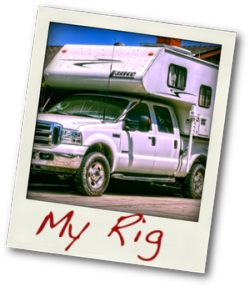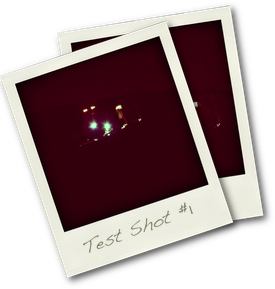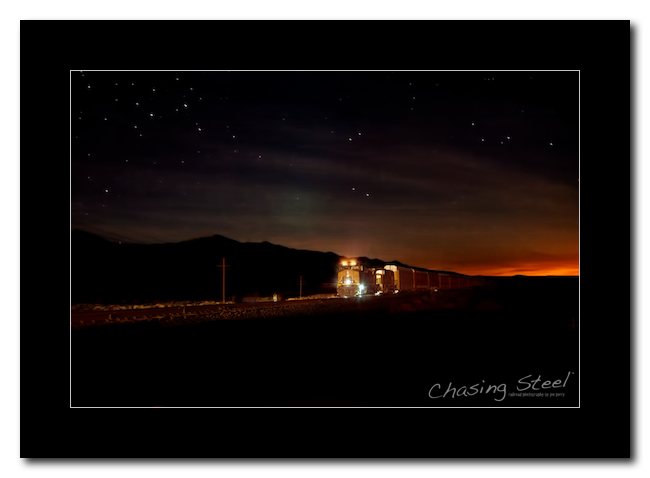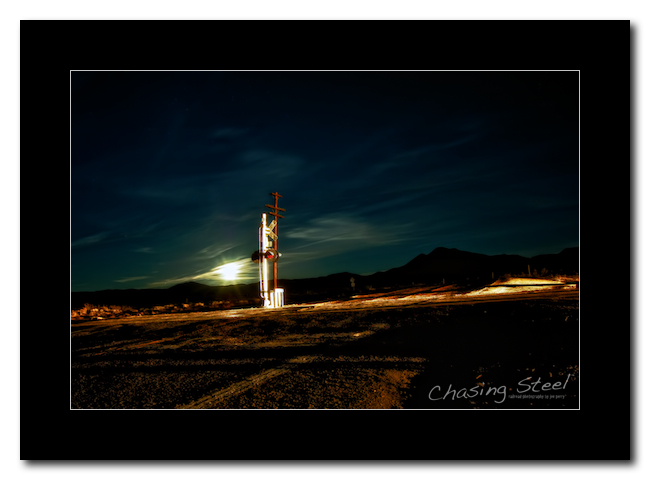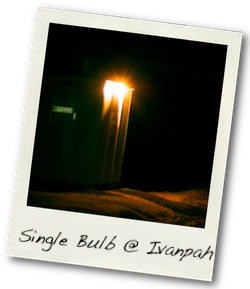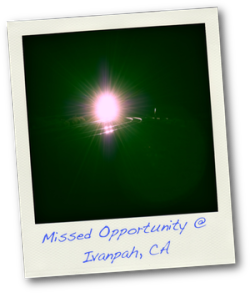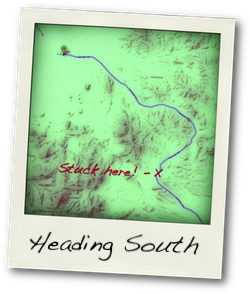Living, Barely - Cima Sub Shots - Part 5 of 5

(Continued from: Living Lucky - Cima Sub Shots - Part 4)
After the day’s events and considering I was content with the shots I had taken already, I decided to head home. As I left the Ivanpah, California grade crossing, I knew of two trains on the normally sparsely populated Cima Subdivision of the Union Pacific Railroad. One was the eastbound vehicle train that kept me company while we both waited for the westbound manifest train at Ivanpah. The vehicle train was now well on its way to Nipton, California and east towards Las Vegas, Nevada. The manifest train was out in front of me somewhere between Ivanpah and Kelso, California by now.
I had no intention of stopping, except perhaps to get gas, before I reached home. However, as I approached Cima I noticed the distinctive and highly illuminating glare of a locomotive’s headlights in my side mirror. I must have caught and past the manifest train. I slowed down to confirm my sighting and gauge the apparent speed of the train. I realized that the train was moving too quick for me to get in position at Cima so I kept an eye out for a potential photo location as I continued towards Kelso ahead of the train.
I found my quarry at the grade crossing at Cedar Canyon Road. This is the road that is noted for being part of the original route of the Mojave Road and a key route through the New York Mountains. In fact, I did drive over the crossing to evaluate the road’s condition on the other side in hopes of possibly reaching the Mid-Hills campground. My hopes were quickly dashed when I saw the road warning sign which read “Flooded.” I drove back across the crossing and parked. (I always try to park on the side of a crossing that I will be leaving from or the side that I will be shooting photos from as I never want to have a train between me and my vehicle.)
I had ample time to set-up my tripod and take a bunch of test shots to figure out what settings would work best. The moon had risen by this time and I was able to leverage the light it afforded me. After taking a series of shots I could see that the moon began to resemble a sun in the longer exposed photos. As such, it gave the scene a surreal daytime/nighttime look. I chose those settings for a few shots and I really like they way they came out.
Here is one shot of the crossing sans train. This shot has three sources of light for the effect. The first is the moon which provides most of the lighting for the scene. The second is some partial lighting from the approaching train, and lastly, I lightly “painted” the light on the cross bucks and telephone poles with my MagLite® flashlight to get them to expose properly because they were in the “shadow” of the moon.
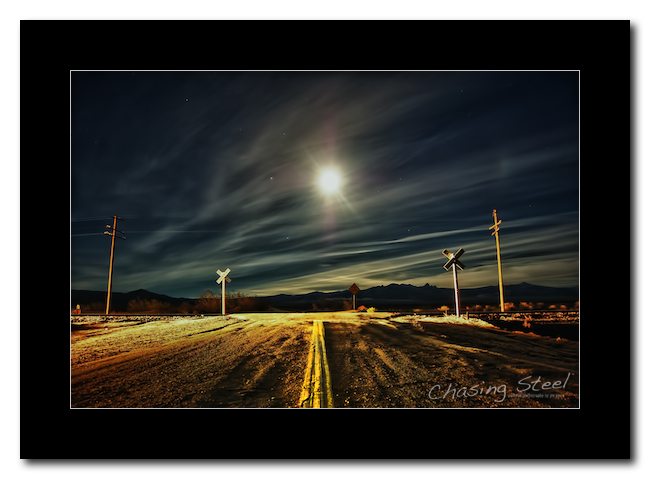 “Coyote Crossing” - Part of the famed “Mojave Road,” the Cedar Canyon Road grade crossing is framed by the moon and the lights of an approaching train. I had become very casual about my surroundings as I was taking this shot and soon after it was taken I found myself the subject of a pack of coyotes’ nightly hunt.
“Coyote Crossing” - Part of the famed “Mojave Road,” the Cedar Canyon Road grade crossing is framed by the moon and the lights of an approaching train. I had become very casual about my surroundings as I was taking this shot and soon after it was taken I found myself the subject of a pack of coyotes’ nightly hunt.
[2/20/2011 - Cima Subdivision] Copyright © 2011 Joe Perry. All rights reserved.I took shot after shot and tweaking the settings in hopes of enhancing my knowledge of night photography and my camera’s (Nikon D50, in this case) capabilities. I loved shooting this crossing because it was barren and desolate. It did not have any distracting crossing gates or lights. I don’t mind the telephone poles too much but I think it might have been a better shot without them.
About 15 minutes after taking the shot above the train finally arrived at the crossing. I left my tripod in the same location, in the middle of the road, since I hadn’t seen another vehicle for hours. It was just me, the moon, and the train. Oh, and the cold. Did I mention that it was about 29F degrees? Yeah, it was and as I held the remote to my camera in the hand, poised to press the shutter release button, I realized that I had lost sensitivity in my fingers by now. Oh well, here comes the train.
I fired off successive shots and altered the settings a bit and then fired some more. I kept this up until the trains length had cleared the crossing. I wasn’t sure what settings would create a cool effect so I tried a bunch of them. Here is one of the better shots of the train blowing through the crossing. I wish I could say that I planned to take exactly this shot and I used these settings to capture the… But the truth is, I am just not there yet. I did know enough to try everything and use my flashlight to help paint the scene though. ;-)
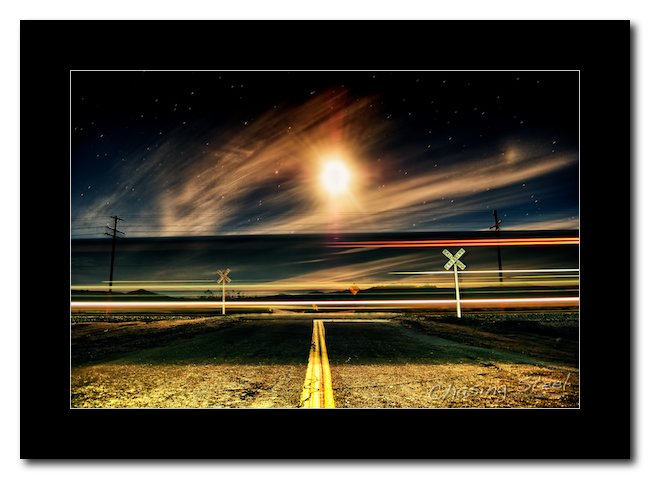 “Coyote Crossing” Train - The Cedar Canyon Road grade crossing with the Union Pacific’s Cima Subdivision is framed by the moon and the lights of an passing train in this time-lapsed photo. I had become very casual about my surroundings as I was taking this shot and soon after it was taken I found myself the subject of a pack of coyotes’ nightly hunt.
“Coyote Crossing” Train - The Cedar Canyon Road grade crossing with the Union Pacific’s Cima Subdivision is framed by the moon and the lights of an passing train in this time-lapsed photo. I had become very casual about my surroundings as I was taking this shot and soon after it was taken I found myself the subject of a pack of coyotes’ nightly hunt.
[2/20/2011 - Cima Subdivision] Copyright © 2011 Joe Perry. All rights reserved.
Once the train blew by my location I briefly considered what other shots I could take there. I was having fun and learning a lot. By this time I was at the crossing for nearly an hour or so and despite the lack of feeling in my exposed parts, I felt like I could keep shooting.
I took up a position behind by tripod and looked through the viewfinder to possibly frame another subject when I was shaken from the moment of having fun by a disturbing sound. At first, the sound didn’t register in my mind. It seemed out of place. It was foreign to my world of shutter clicks and squealing wheels on steel rails mixed with the low drumming sound of massive diesel engines.
Then I heard it again.
This time, it sent shivers down my spine. I suddenly felt like an explorer in a far away land. The hairs on my arm stood up. Uh oh. Instinctively I knew this was potentially a bad thing. Then it got worse.
This time when the I heard the coyote’s howl I realized it was coming from directly ahead of me on the road, in the dark. I was in the dark. He was in the dark. He could see. I couldn’t. Just then I heard another howl, and then another, and another. In rapid succession, there was the main coyote call followed by three others in a semi-circle around me. And they all were close - within 75 yards or so. Oh shit!
I had become so caught up in my photography that I forgot I was in a preserve in the middle of nowhere. There is wildlife all around me. In this case, the wildlife could case me grief. Naturally my mind told me that the calls were the gang ensuring that everyone was in position before they moved in for the kill. Wait, I am in the middle of this. Oh shit, I am the kill!
I grabbed my tripod and hustled to my truck like a the next victim of some horror movie. I even did the “fumbling keys” bit as well. I eventually reached the safety of Fort Ford and, as I closed and locked (really?) the doors behind me, I took a moment to make sure that I didn’t leave any equipment behind. “Nope, should be good. Let’s go home.” I told myself.
I didn’t survive the black abyss and being stuck in muck and mud only to be consumed by a pack coyotes - or werewolves! By my calculations, I have seven lives left.
In keeping with my tradition, Cedar Canyon Road will be forever known as “Coyote Crossing.” ;-)
The end.
 Cima,
Cima,  HDR,
HDR,  Mojave National Preserve,
Mojave National Preserve,  Union Pacific CATEGORIES:
Union Pacific CATEGORIES:  General Photography,
General Photography,  Railroad Photography,
Railroad Photography,  Ramblings and Such
Ramblings and Such 
